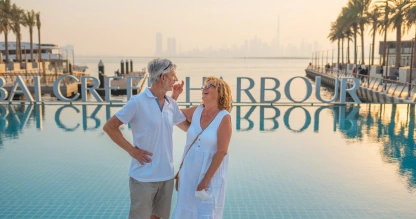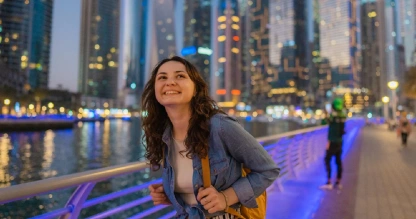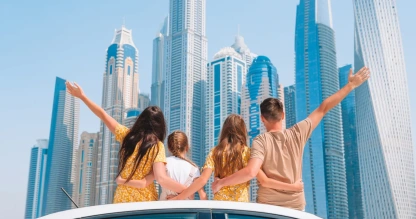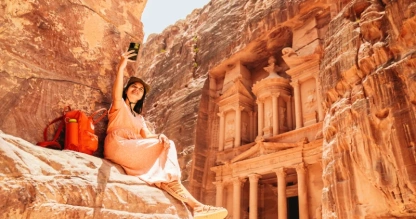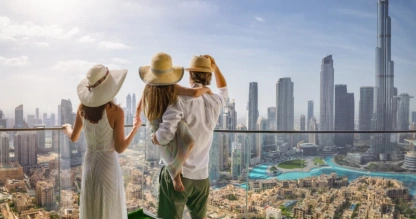
Burj Al Arab: Dubai’s Luxury Icon
The Burj Al Arab stands majestically at 321 meters (1,053 ft) tall on its own artificial island and ranks among the world's tallest hotels. This definitely makes it one of the most luxurious hotels globally. The architectural marvel required US$1 billion to build and contains over 70,000 cubic meters of concrete and 9,000 tons of steel. The structure has become synonymous with opulence.
Dubai's Burj Al Arab remains one of the city's top attraction and a must-visit during Dubai tours, thanks to its distinctive sail-shaped design and exceptional luxury offerings. A private curving bridge connects this iconic hotel to the mainland, where 199 exclusive suites await guests. Each suite comes with dedicated staff members and 24-hour butler service. The smallest suite measures an impressive 169 square meters (1,820 sq ft), while the Royal Suite ranks among the world's most expensive hotel accommodations.
First impressions: arriving at Burj Al Arab in Dubai
The Burj Al Arab in Dubai gives visitors their first taste of unmatched luxury. The iconic destination stands on its own artificial island, connected to the mainland by a stunning 280-meter curved private bridge. This clever positioning keeps the hotel's shadow away from Jumeirah Beach while creating an exclusive atmosphere.
The private bridge and island setting
This private bridge does more than connect - it sets the stage for a meticulously planned luxury experience. The bridge stays under constant security surveillance. Only guests with confirmed reservations or tour bookings can cross.
Dubai International Airport sits about 25 minutes away. The Inside Burj Al Arab tour provides guests with special buggy escorts from the Ticket Lounge across this remarkable bridge. The bridge's midpoint has become a popular spot for what many call "the ultimate selfie" with the sail-shaped hotel as the perfect backdrop. These photos have become some of the most shared images on social media worldwide.
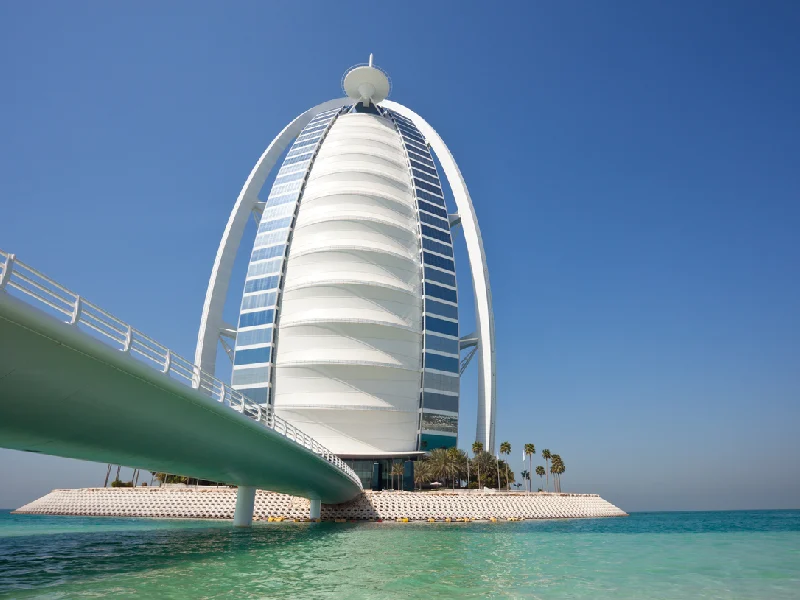
Welcome rituals and Arabian hospitality
Arabian hospitality shines the moment guests cross the bridge. Staff members wear beautiful gold-threaded kandoras and welcome everyone with genuine warmth, whatever their mode of arrival.
The welcome starts with signature lemonade and cool, moist toilettes - perfect after Dubai's heat. Tour guests receive an extra special touch: a traditional Emirati welcome ceremony led by a dedicated butler who introduces them to the hotel.
This carefully crafted welcome shows the hotel's steadfast dedication to authentic Arabian hospitality and luxury standards. The arrival experience - from crossing the bridge to the welcome ceremony - proves why Burj Al Arab stands at the peak of Arab hospitality.
Each element creates an unforgettable first impression that hints at the extraordinary moments waiting inside this architectural marvel.
What makes the architecture so unique
The Burj Al Arab stands as an engineering masterpiece and Dubai's global symbol. British architect Tom Wright created this architectural wonder that represents way beyond luxury accommodation. The building embodies cultural heritage while showcasing a futuristic vision.
The sail design and structural innovation
Dubai's Crown Prince tasked Wright to build more than just a hotel - he wanted a distinctive landmark to represent Dubai globally. A modern sailing yacht caught Wright's eye and inspired him to shape the building like a billowing sail of a dhow - a traditional Arabian vessel. This design pays tribute to the region's maritime roots while pushing boundaries into the future.
The building's unique V-shaped floor plan features two "wings" that spread outward to create a "mast". A lightweight steel exoskeleton works with strategic mass shock absorbers to withstand Dubai's strong winds. The exterior showcases a distinctive Teflon-coated fiberglass facade. During the day, it reflects sunlight, and at night, it transforms into a projection screen.
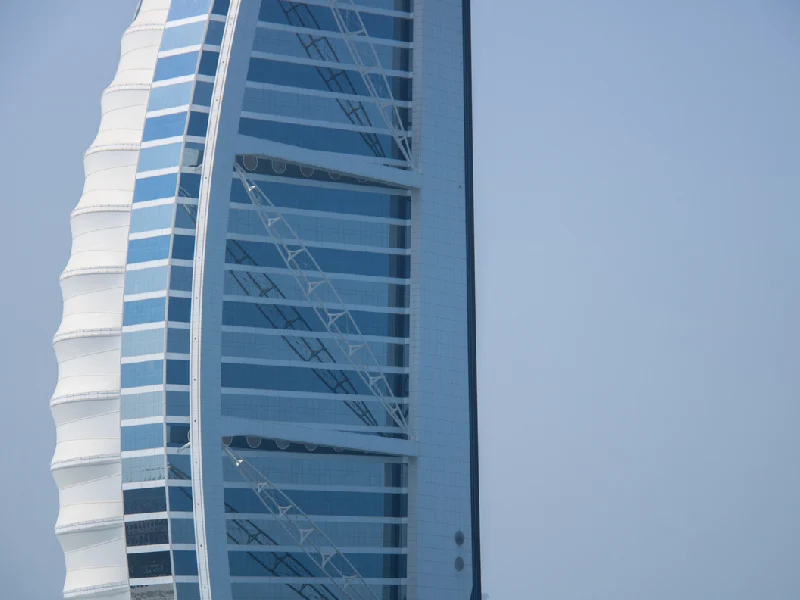
Engineering the artificial island
The team built an artificial island 280 meters offshore to support the Burj Al Arab. They drove 230 concrete piles into the seabed, each stretching 40 meters long. The structure's stability comes from sand friction along the piles' length since engineers found no bedrock even 180 meters below.
The team developed a groundbreaking concrete honeycomb pattern around large rocks to protect against erosion. This solution shields the foundation from powerful waves effectively. The artificial island's construction lasted three years - longer than building the hotel itself.
The atrium and panoramic elevators
The world's tallest atrium welcomes visitors with its impressive 180-meter height. This breathtaking space showcases:
- Imposing golden columns flanking both sides
- A translucent fabric wall made of PTFE-coated fiberglass
- A double-layered membrane that filters natural light while blocking excess heat
Mitsubishi elevators zip through this remarkable space at 8 meters per second. These panoramic lifts connect Level 2 with Level 27 (structurally the 4th and 54th floors), treating guests to stunning views of both the interior architecture and the Arabian Gulf.
Experiencing the luxury: tours, suites, and dining
The Burj Al Arab delivers exceptional luxury through its exclusive rooms, restaurants, and custom tours that go beyond its architectural magnificence.
Inside the royal suite: a museum-like tour
Visitors can now explore this 780-square-meter lavish space through guided tours. The suite sits on the 25th floor and serves as a museum-like space where guests walk in the footsteps of royalty and celebrities.
Dining with a view: Al Muntaha and more
Al Muntaha restaurant sits 200 meters above the Arabian Gulf on the 27th floor. The restaurant pairs breathtaking panoramic views with its Michelin-starred menu. Chef Saverio Sbaragli leads the kitchen with sophisticated French and Italian cuisine. The hotel features six more restaurants. Ristorante L'Olivo at Al Mahara stands out with its impressive aquarium where guests enjoy seafood while marine life swims around them.
Photo ops, golden cappuccinos, and extras
The Skyview Bar on the 27th floor serves one of Instagram's most photogenic drinks—the 24-carat gold cappuccino. These golden drinks—from espresso martinis to frappuccinos—create perfect photo moments against Dubai's sparkling skyline.
What the Inside Burj Al Arab tour includes
The official tour runs 60-90 minutes and starts at the check-in lounge across from Jumeirah Beach Hotel. Guests ride a buggy across the private bridge and receive a traditional Emirati welcome with cool towels and welcome drinks. The tour takes you through the hotel's atrium and Royal Suite. It ends with Arabic coffee and dates before you descend in the gold-plated elevator.
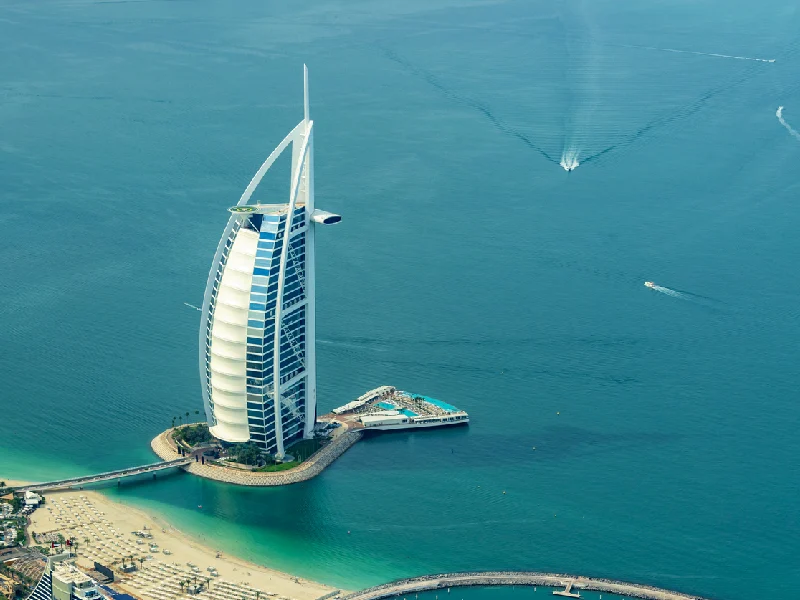
Beyond the hotel: its place in Dubai’s identity
The Burj Al Arab exceeds its role as a luxury hotel and stands as modern Dubai's unofficial symbol. This architectural masterpiece has grown from a hospitality venue into a cultural icon that represents the emirate's ambitious vision since 1999.
How Burj Al Arab shaped Dubai's global image
Dubai's Burj Al Arab has become as recognizable as Paris's Eiffel Tower. The distinctive sail-shaped structure appears on Dubai's license plates, tourism materials, and countless souvenirs. Media coverage of Dubai features the Burj Al Arab as a visual symbol of the city's transformation from desert outpost to global metropolis. The hotel's unique profile gives Dubai an identifiable symbol that speaks of luxury, state-of-the-art design, and Arabian heritage.
Comparisons with other Dubai landmarks
Dubai now features many impressive structures—from the record-breaking Burj Khalifa to the Palm Jumeirah archipelago. The Burj Al Arab still holds a special place among them. Newer landmarks might be taller or more technically advanced, but none are a match for its iconic status or global recognition. The city's skyline grows more crowded with architectural wonders, yet the Burj Al Arab remains the premier symbol of Dubai's experience.
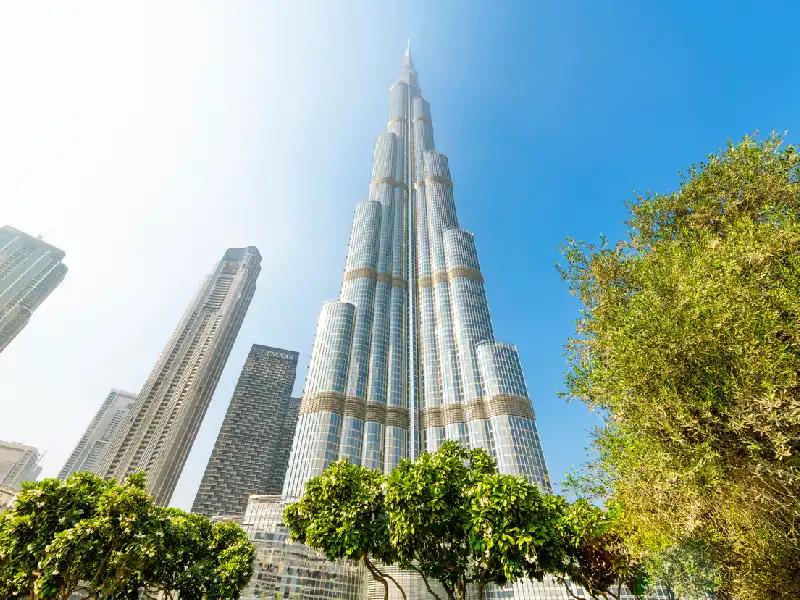
Why it's more than just a hotel
The Burj Al Arab means more than just rooms and restaurants. It represents Dubai's story of bold ambition and endless possibility. The structure brings vision to life—a physical example of Dubai's "nothing is impossible" mindset. This symbolic value explains why visitors who never stay overnight still see the Burj Al Arab as vital to understanding modern Dubai.
Tips for Visiting Burj Al Arab for the First Time
1. Book in Advance
Access to Burj Al Arab is limited — you can’t just walk in. Make sure you reserve a dining experience, afternoon tea, or spa treatment well ahead of time.
2. Dress Smartly
This isn’t a casual spot. Smart casual or elegant attire is expected, especially if you’re dining in one of its fine restaurants.
3. Plan Extra Time
Arrive early to enjoy the iconic architecture, the private bridge entrance, and the luxury setting without rushing.
4. Capture the Views
Don’t forget your camera — whether it’s the grand atrium inside or panoramic views of Dubai’s coastline, every angle is Instagram-worthy.
5. Respect the Etiquette
Be mindful of hotel guests, follow the staff’s guidance, and remember that some areas are restricted to visitors.
FAQS
Q1: Why is Burj Al Arab famous?
It’s world-renowned for its sail-shaped design, ultra-luxury suites, and being one of the most photographed landmarks in Dubai.
Q2: Where is Burj Al Arab located in Dubai?
It sits on a private artificial island just off Jumeirah Beach, connected to the mainland by a private bridge.
Q3: When was Burj Al Arab built?
Construction began in 1994, and the hotel officially opened its doors in December 1999.
Q4: How was Burj Al Arab built?
Burj Al Arab was constructed on a man-made island, using advanced engineering techniques to anchor it securely. It took five years to build, opening in 1999.
Q5: What makes Burj Al Arab 7-star?
Officially, hotels can’t have more than 5 stars, but Burj Al Arab earned its “7-star” reputation from a journalist who described its unmatched luxury and service.
Q6: Can you go inside Burj Al Arab?
Yes, but access is limited. Visitors need a confirmed reservation for dining, afternoon tea, or the spa — you can’t just walk in without one. Alternatively, you can book the Inside Burj Al Arab tour, which gives exclusive access to parts of the hotel, including the Royal Suite and curated exhibitions.
Discover the wonders of Dubai with our Dubai Tours and the best of Middle East trips!

